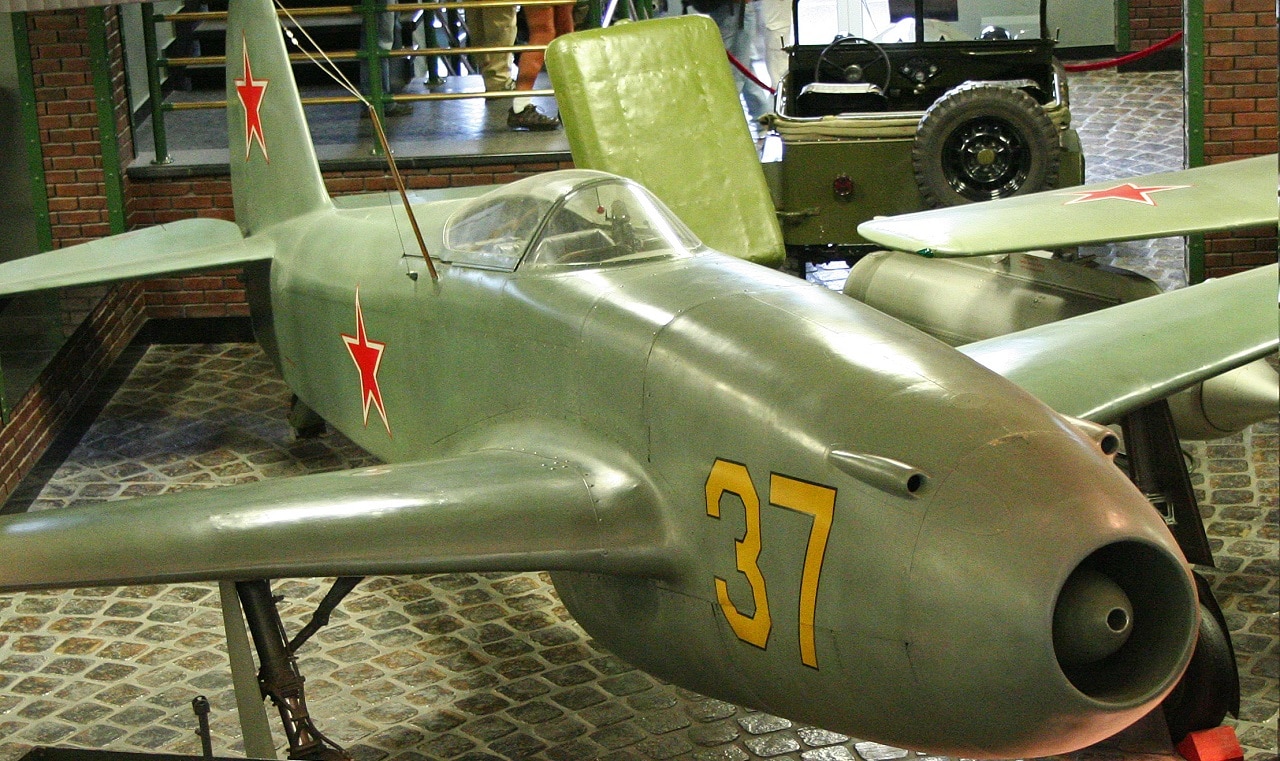The Cold War, in addition to being an ideological struggle of capitalism vs. Communism and democracy vs. totalitarianism, was also one of technological bragging rights, a constant contest to be the first to achieve.
The Soviets got there first in the area of spaceflight. On the other hand, the U.S. and her allies got there first when it came to the atomic bomb and hydrogen bomb.
Then there was the arena of jet fighters. Nazi Germany had the first operational jet fighter, the Messerschmitt Me 262 Schwalbe (“Swallow”). But the Americans and British could still take pride in operating their own jet fighters, the P-59 Airacomet and Gloster Meteor, before the Russians. The Soviets didn’t lag too far behind, though. They would soon enter the Jet Age on the wings of the first Soviet jet fighters, the Yak-15 and MiG-9.
MiG-9 and Yak-15: Early History and Specifications
The Yakovlev Yak-15 and Mikoyan-Gurevich MiG-9 both made their maiden flights on April 24, 1946. Though the Yak was built first, having had its inception in April 1945, the MiG flew first after winning a coin toss. Its first flight lasted six minutes. The U.S. Department of Defense gave the MiG and Yak the rather plain-Jane designations of Type 1 and Type 2, respectively, while NATO gave them the respective reporting names of “Fargo” and “Feather.”
Specifications of the MiG-9 included a length of 32 feet, a wingspan of 32.8 feet, a height of 13 feet, an empty weight of 7,540 pounds, and a max takeoff weight of 11,177 pounds. Maximum airspeed was 566 miles per hour (Mach 0.73). Armament consisted of a 37mm Nudelman N-37 automatic cannon extending from the nose intake divider and two 23mm Nudelman-Suranov NS-23 auto-cannon protruding from the undersides of the nose intake.
Meanwhile, specifications of the Yak-15 included a length of 28.8 feet, a wingspan of 30.2 feet, a height of 7.2 feet, an empty weight of 4,228 pounds, and a maximum takeoff weight of 13,327 pounds. Max airspeed was 500 miles per hour (Mach 0.65). Armament consisted of two NS-23s located in the nose.
By comparison, the aforementioned American Airacomet and British Meteor had max airspeeds of 413 mph (Mach 0.53) and 415 mph (Mach 0.54).
Operational Performance
As Russell Miller noted in his excellent 1983 book The Soviet Air Force at War (from the Time-Life Books “Epic of Flight” series), “At the end of World War II, Russia had still not produced a successful jet engine. Now, less than two years later, the May Day fly-past was led by formations of Yak and MiG jets, making their public appearance for the first time.”
However, as has often been the case with Russian military technology, problems lurked beneath the surface.
Regarding the MiG-9, MilitaryFactory.Com notes: “With turbojet design mechanics and tactics still in its relative infancy, the MiG-9 was also a design that was inherently prone to airframe and engine failures.” Among other things, firing its guns could cause the engines to flame out.
Its underwhelming performance notwithstanding, the “Fargo” earned its designers, Artem Mikoyan and Mikhail Gurevich, the Stalin Prize in 1947. Per MilitaryFactory.com: “[T]hough hardly a successful design – the MiG-9 formed the basis and forerunner to the excellent MiG-15 aircraft popularized by its use in the Korean War (1950-1953).”
As for the Feather, Henry Kelsall wrote for HotCars that “It was the first truly successful jet fighter to emerge from the country, and proved to its aircraft designers that jet aircraft could work. It certainly had its issues, such as its piston-engine origins and its awkward ground handling. But it was an important step for a country that was about to lag behind those in the West.”
The Yak-15 was retired in 1953 after 280 were built. The MiG-9 remained in production until 1948, with 598 built and at least 372 sent to Communist China.
Where Are They Now?
There are two surviving Fargos. Unfortunately for American would-be tourists, they’re both located in countries with whom the United States does not have friendly relations: China and Russia. More specifically, they’re housed at the Chinese Aviation Museum, Datangshan, Beijing, and the Central Air Force Museum, Monino, Moscow Oblast. Likewise, the only surviving Feather is on display at the Vadim Zadorozhny’s Museum of Equipment in the Krasnogorsky District of Moscow Oblast.
Ergo, the closest my fellow aviation history enthusiasts holding U.S. citizenship status will come to seeing either one of these warbirds in the meantime is in the guise of plastic models. Accordingly, the online hobby shop Scalemates has multiple model kit options available for both warbirds, with sizes ranging from 1:144 to 1:32 scale.
About the Author
Christian D. Orr is a Senior Defense Editor for 19FortyFive. He is a former Air Force Security Forces officer, Federal law enforcement officer, and private military contractor (with assignments worked in Iraq, the United Arab Emirates, Kosovo, Japan, Germany, and the Pentagon). Chris holds a B.A. in International Relations from the University of Southern California (USC) and an M.A. in Intelligence Studies (concentration in Terrorism Studies) from American Military University (AMU). He has also been published in The Daily Torch and The Journal of Intelligence and Cyber Security. Last but not least, he is a Companion of the Order of the Naval Order of the United States (NOUS).
From the Vault
The Navy Sent 4 Battleships To Attack North Korea
‘Sir, We Hit a Russian Submarine’: A U.S. Navy Sub Collided with a Nuclear Attack Sub

